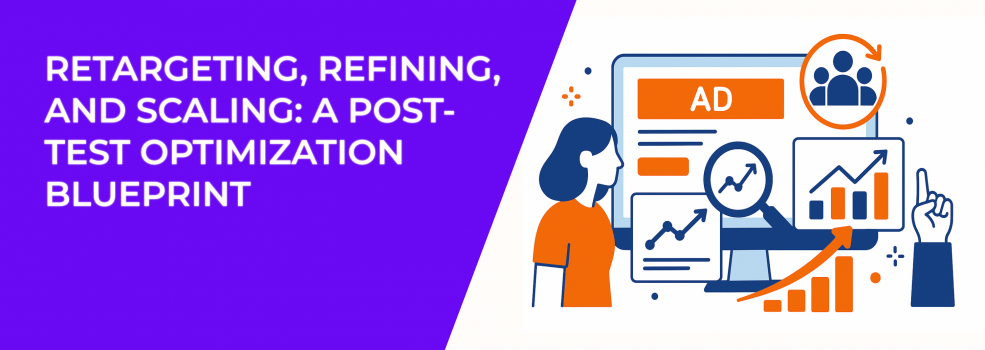After testing your Facebook and Instagram ads, what’s next?
Post-test optimization is often where advertisers lose momentum. But this is the phase where good campaigns are sharpened — and turned into scalable winners. Each move you make after testing either strengthens performance or stalls it.
This article outlines a simple yet strategic blueprint across three key stages: Retargeting, Refining, and Scaling. It’s built for advertisers who want more control over their results and are looking to go beyond surface-level targeting. If you’re using LeadEnforce, these steps can give you even greater precision and impact.
Retargeting: Re-Engage and Convert with Focus
Initial engagement is useful — but it’s what happens afterward that drives conversions. Retargeting helps capture those who interacted with your ads but didn’t take action.
To do this well, segmentation is essential. Users behave differently, so treat them differently:
-
Video viewers: Retarget based on how much of the video they watched (25%, 50%, 95%). Tailor your follow-up creative to match their interest level.
-
Page visitors: Show product-specific ads to users who visited particular landing pages.
-
LeadEnforce-sourced users: Use engagement data from specific Facebook or Instagram communities. People who are active in niche groups often convert at higher rates.
LeadEnforce allows you to build custom audiences based on group activity — not just likes or follows. This means you can retarget users who actively engage with content from competitors, industry influencers, or niche communities.
Retargeting users based on behavior (e.g., video viewers vs. landing page visitors) can yield varying conversion rates, which is why it's essential to test different segments in your campaigns.
Tips for better retargeting:
-
Exclude users who have already converted within a recent time frame (7–14 days) to avoid wasted impressions.
-
Use dynamic product ads for abandoned carts or catalog viewers.
-
Create urgency in your messaging — limited-time offers, restock alerts, or expiring discounts work well.
Want more conversions without raising spend? Retargeting is where you look.
Still weighing whether to double down on retargeting or expand wider? This comparison of retargeting vs. broad targeting explains which approach performs best based on campaign goals.
Refining: Turn Data into Better Ads
Once you’ve tested, avoid the temptation to scale immediately. First, refine.
At this stage, you’re working with clear signals. Some creatives worked. Others didn’t. Certain segments clicked, others scrolled past. Use this feedback to shape smarter decisions.
Start with your creative and copy. Break down what worked:
-
Creative: Which visuals attracted attention? Were videos more effective than images?
-
Headlines: Did value-based messaging perform better than curiosity-based hooks?
-
CTAs: Were users more responsive to “Learn More” or “Shop Now”?
Sometimes, achieving better performance is as simple as tweaking your ad a bit: making the copy shorter, adding a more actionable CTA, etc.
Then refine targeting. If you found a strong-performing audience using LeadEnforce — say, members of a fitness coaching group — explore related communities or segment deeper. Niche pages and groups often unlock higher intent.
What to refine post-test:
-
Ad Copy: Emphasize benefits more clearly. Cut fluff. Test different lead-ins or opening lines.
-
Creative Format: Try different media types — carousel, video, single image, Stories.
-
Landing Pages: Reduce friction. Remove unnecessary fields. Improve mobile experience.
-
Targeting Parameters: Narrow by page activity, not just page follows, using LeadEnforce.
Pro tip: instead of duplicating high-performing ads, build on them. Test one variable at a time — otherwise, you’ll never know what really moved the needle.
If you’re unsure which variable to adjust first, this guide breaks down whether to test creative, copy, or audience and in what order.
Scaling: Expand Without Breaking Performance
Scaling too soon is a common mistake. If the foundation isn’t strong, scaling just multiplies inefficiency. But once retargeting and refinement are in place, you can move forward with confidence.
Scaling isn’t just about budget. It’s about structure, reach, and creative refresh.
Start with horizontal scaling. This means expanding your targeting pool — not your ad spend. Use LeadEnforce to create new audiences from similar pages or groups that match your current best-performers. These users are often overlooked by Facebook’s interest targeting.
Then explore vertical scaling. Increase your daily budget gradually — 15–20% every few days — while monitoring for cost spikes or frequency issues.
Scaling checklist:
-
Launch new ad sets targeting different LeadEnforce audiences with similar intent profiles.
-
Refresh creatives weekly to prevent ad fatigue.
-
Monitor performance daily — not just CTR, but also CPA and ROAS.
-
Adjust bids and placements if you see uneven results.
Avoid pushing spend into an exhausted audience. Use lookalikes based on high-value LeadEnforce audiences to find new potential without sacrificing quality.
For more efficient scaling, especially when budgets grow fast, explore how Advantage+ Budget Allocation can streamline the process without compromising control.
Closing Thoughts
Post-test optimization is where campaigns evolve. It’s not about making one big change — it’s about consistent, focused improvement. When you combine strategic thinking with tools like LeadEnforce, you create campaigns that not only perform but scale sustainably.
If you’ve been testing ads without a clear follow-up plan, now is the time to rethink your approach.
Retarget to re-engage. Refine to improve. Scale when it’s ready.
And always build on what you’ve learned.

